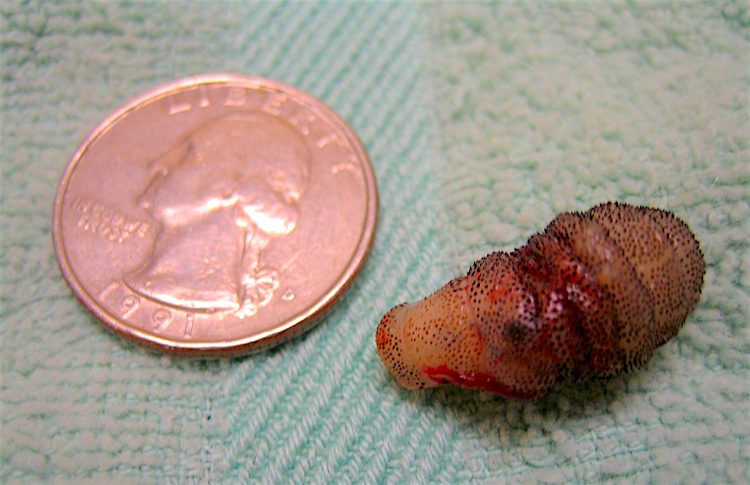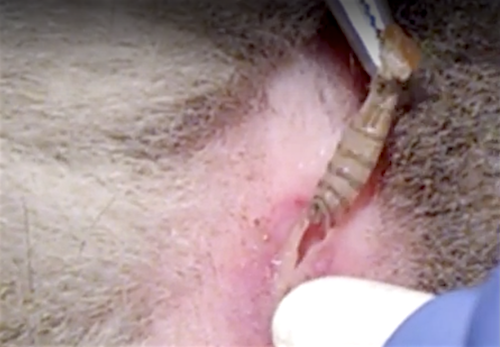
Late summer/early fall. That means it’s time for garden mums, harvest moons, peaches and an X-file maggot poking its head out of the side of your little dog or cat. That’s right, it’s Cuterebra time.
Never heard of a Cuterebra? You’re not alone. These botflies are not that common, but when people find one on their pet, they don’t forget it.
I usually remove 5 or 6 of these gross little critters from dogs, cats or rabbits each year. Even though they are not that common, if you live in a rural or semi-rural area, it’s good to know what they are so you don’t freak out if you find one poking its head out of your pet.
About the Cuterebra
The Cuterebra fly is a large, non-biting, fat fly that lays its eggs near rodent or rabbit burrows on grass, rocks and vegetation.
- Your cat or dog passes by the area, maybe sniffing out a mouse, and picks up the eggs on her coat.
- The eggs hatch into larvae and invade the dog or cat through the mouth, nasal passages, or an external wound.
- Then these creepy little larvae travel under the skin of your pet and set up house somewhere on the head, neck or body. The creeps grow inside their little houses, creating round swellings, little larvae bungalows — sometimes called warbles. (Here’s a pretty gross photo of them.)
- Each one makes a little breathing hole, like a chimney, in the middle of the swelling.
Not a Good Candidate for “DIY”
This is when you might run your hand across this peculiar bulge, look down, and see Larva-Man poking its ugly little head out of the “chimney.”
Feeling a little sick to your stomach, you run to your medicine cabinet and get your tweezers for a do-it-yourself surgery, right? Wrong. Although icky and disgusting, this is not an emergency. Mr. Thing has actually been squirming around inside your pet for about 1 month by now. Save the tweezers for your eyebrows — call the veterinarian.
It’s important to remove the Cuterebra in one piece. If you break it into pieces, you can create a large inflammatory reaction in your pet.
I was awakened the other evening by a very calm woman. “There’s a maggot in a hole on my terrier, and I can see its head going in and out,” she said.
I was so impressed with this woman’s presence of mind. I explained what it was, that it was not an emergency, and asked if she could wait a few hours until my office opened in the morning. I had some limited hours on Labor Day weekend. She was grateful not to have to go to the emergency hospital. We saw Scully in the morning, removed Cathy Cuterebra from her hut, squished Cathy to death, and everyone, especially Agent Scully, had a happy holiday.

Preventing Alien Invasions
For rural dogs and cats, there’s no perfect solution if they lie outside near wild rabbits or rodents.
- Leash-walking dogs and keeping cats indoors is, of course, great prevention.
- Knowing what a Cuterebra is and what it looks like can reduce the shock factor if you see something like this on your pet.
- I’ve seen many pet bunnies with this parasite because rabbits are a preferred host. These bunnies are usually allowed to play and exercise on grass. Bunnies in hutches should not be prone to Cuterebra.
When There Are More Than One
Cuterebra are usually a single critter, rating about a 5 out of 10 on the gross-out scale.
Whenever I’m ready to remove a Cuterebra, I usually call in the new employees so they can have a look. “Yuck. Wow! How cool!” is a typical response.
But even hard-core veterinary professionals don’t enjoy maggots. Here’s a typical, late summer scenario: A sick 12-year-old collie comes in after a week of 95-degree weather with diarrhea. What else do you think might be hiding under the matted, stinking tail? You guessed it. A maggot-fest.
Where did all my technicians go? They’re suddenly all on break? Well, they better eat now. They won’t have an appetite later.
Risk Factors
If this ever happens to you, don’t be embarrassed. But you need to get to the vet. Let me point out some risk factors so maggot infestations can be avoided.
Maggots:
- Occur in thick-coated breeds most often. Poorly groomed collies and shelties are the primary example. (But they can occur in any dog breed or cat.)
- Occur in hot weather, because of fly strike.
- Occur more commonly in older, recumbent animals who don’t groom or stay in one, outdoor place for a long time.
- Occur if the animal already has a wound or is soiled around the rectal/vaginal area.
These pets can become very sick from the associated infection caused by maggots (myiasis).
Was YOUR Pet Food Recalled?
Check Now: Blue Buffalo • Science Diet • Purina • Wellness • 4health • Canine Carry Outs • Friskies • Taste of the Wild • See 200+ more brands…

This Is a Problem for the Vet to Fix
Get your pet to the vet if you even suspect maggots so the animal can be examined and the entire area can be professionally clipped, de-maggotized, surgically cleaned and medicated. I have had several debilitated animals running temps as high as 106 degrees because of maggots. These guys may need IV fluids and IV antibiotics to be stabilized. If the animal was sick or debilitated before the maggot problem, the combination of illness and parasites can be fatal.
I took a quick poll, and most vets and techs don’t think there are too many grosser things out there than creepy crawlies. I usually work these cases myself because I don’t want anybody else fainting.
As is our mantra in the veterinary profession, don’t just “wait a few more days,” particularly if you see a swelling, an area of matted fur or a wound of unknown origin. Don’t let your pet become Lord of the Flies!
This pet health content was written by a veterinarian, Dr. Debora Lichtenberg, VMD. It was last reviewed Sept. 5, 2012.



